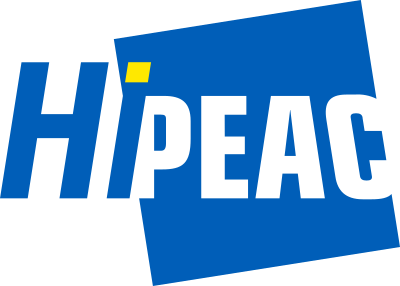HiPEAC 2020
Please, give us a feedback!
| Event | HiPEAC 2020 | ||||||||||||||||
| Where | Bologna | ||||||||||||||||
| When | 20 – 22 January, 2020 | ||||||||||||||||
| Event Website | https://www.hipeac.net | ||||||||||||||||
| Involved Partners | ALL | ||||||||||||||||
| Organizers | Francesca Palumbo (UNISS), Evgeny Shindin (IBM Research Haifa) | ||||||||||||||||
| Benefits & Target | Cerbero participation to the event aims at divulgation of the CERBERO toolchain capabilities among companies and researches attending at HiPEAC 2020 | ||||||||||||||||
| Description | Cyber-physical systems (CPS) represent the cutting edge of the ICT. They provide control, interaction and communication over, with and among the physical and the cyber world. CPS combine computing devices, interfaces, and networks with the environment to sense and provide feedback, increasingly often implementing autonomous and intelligent interactions. Dealing with CPS development requires spanning over a plethora of heterogeneous topics, which makes the process of their definition, analysis and design a challenging task. Moreover, to interact with the environment or humans the system has to be capable of providing a certain degree of flexibility, which certainly adds to the challenges. Tools to be used span from verification to modeling, and from mapping to high-level synthesis across many levels of abstraction, and must allow a combination of physical or continuous dynamics. Last but not least, CPS should react to and handle a large variety of possible perturbations, such as change in requirements, time delays, and system failures. All these issues have been fronted in CERBERO – Cross-layer modEl-based fRamework for multi-oBjective dEsign of Reconfigurable systems in unceRtain hybRid envirOnments H2020 project (www.cerbero-h2020.eu). This tutorial is meant to represent the final event of the project, and is organized in 4 slots as follows: | ||||||||||||||||
| Schedule |
|
Sessions Description
SESSION 1: The CERBERO Project – Challenges and Solutions
CERBERO overview, Francesca Palumbo (UNISS) – presentation
Scientific Highlights
- Advancement on (dataflow) MoCs, Eduardo Juarez (UPM) – presentation
- CERBERO Intermediate Format CIF, Evgeny Shindin (IBM Research Haifa) – presentation
- Key Performance Indicators, Francesco regazzoni (ALaRI – USI) – presentation
- CEBERO Adaptation Loop, Eduardo de la Torre (UPM) – presentation
- Formal methods in the CERBERO Toolchain, Luca Pulina (UNISS) – presentation
SESSION 2: HANDS on “Tools Interoperability – Intra-tool interoperability using the CERBERO Interoperability Framework”
Speakers: Julio Oliveira (TN0) and Michiel van den Baar (TNO) – Presentation
SESSION 3: HANDS on “Adaptation over Heterogeneous Embedded Computing Infrastructures”
Speakers: Tiziana Fanni (UNISS), Daniel Madroñal (UPM), Maxime Pelcat (INSA), Alfonso Rodriguez (UPM), Carlo Sau (UNICA), Leonardo Suriano (UPM) – presentation
SESSION 4: The CERBERO Project – Impact, Demo and Clustering
Clustering: DEIS, BONSEYES, CPSWARM
Walking UC DEMO tour
Self-healing system for Planetary Exploration, Speaker: Pablo Sánchez de Rojas(TASE) – presentation
Smart Traveling for Electric Vehicles, Speakers: Joost Adriaanse (TNO), Antonella Toffetti (CRF) – presentation
Ocean Monitoring, Speakers: Hans Myrhaug (AS), Leszek Kaliciak (AS) – presentation
Useful Information for HANDS on Sessions
Two hands on will be given to allow the participants getting familiar with some of the CERBERO outcomes. To enjoy these tutorials, participants should install in their laptops the software Oracle-VirtualBox (you can download it at https://www.virtualbox.org/).
We will bring the installer (you can find us at the booth since Monday), but installing it in advance is advisable.
Please note that,
- Network connection for the virtual box is not necessary.
- Images and installer will be available at the booth since Monday, if you do not have time to download the images before you leave for Bologna.
- Images will be also distributed at the beginning of the tutorial by circulating them in the classroom.





 © 2017 CERBERO | All Rights Reserved |
Project ID: 732105,
Funded under: H2020-EU.2.1.1. - INDUSTRIAL LEADERSHIP - Leadership in enabling and industrial technologies - Information and Communication Technologies (ICT).
© 2017 CERBERO | All Rights Reserved |
Project ID: 732105,
Funded under: H2020-EU.2.1.1. - INDUSTRIAL LEADERSHIP - Leadership in enabling and industrial technologies - Information and Communication Technologies (ICT).